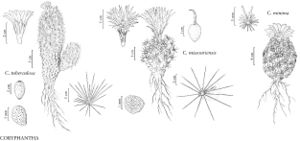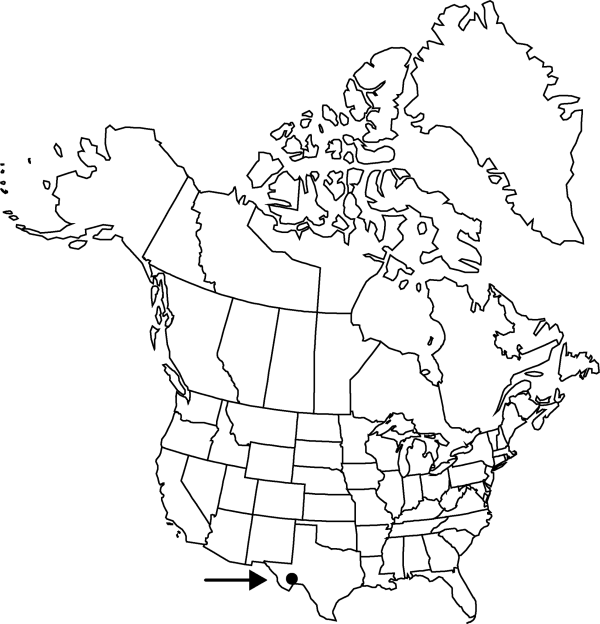FNA>Volume Importer |
FNA>Volume Importer |
| Line 29: |
Line 29: |
| | }}<!-- | | }}<!-- |
| | | | |
| − | --><span class="statement" id="st-d0_s0" data-properties="plant architecture;plant architecture or pubescence or relief"><b>Plants </b>usually unbranched (or branches 2–3; branched profusely in cultivation), smooth.</span> <span class="statement" id="st-d0_s1" data-properties="root density;taproot height or length or size"><b>Roots </b>diffuse or short taproots, largest roots basally 19–63 (average 33) % of greater stem diam.</span> <span class="statement" id="st-d0_s2" data-properties="stem location;stem shape;stem shape;stem shape;stem length;stem atypical width;stem width;apex shape;apex prominence;ground position relational"><b>Stems </b>deep-seated with only hemispheric apex protruding above ground level, spheric to cylindric, 1–2.7 × 0.6–1.7 (–2.5) cm;</span> <span class="statement" id="st-d0_s3" data-properties="tubercle length;tubercle width">tubercles 2–5 × 2–4 mm;</span> <span class="statement" id="st-d0_s4" data-properties="areolar gland count">areolar glands absent;</span> <span class="statement" id="st-d0_s5" data-properties="parenchyma coating">parenchyma not mucilaginous;</span> <span class="statement" id="st-d0_s6" data-properties="druse count">druses present in the stem and tubercle cortex (large lenticular druses absent);</span> <span class="statement" id="st-d0_s7" data-properties="pith count">pith 1/5–1/3 of lesser stem diam.;</span> <span class="statement" id="st-d0_s8" data-properties="medullary system architecture;medullary system count">medullary vascular system absent.</span> <span class="statement" id="st-d0_s9" data-properties="spine count;spine fixation or orientation;spine coloration;spine coloration;spine coloration;spine coloration;spine condition;spine coloration;tip coloration;tip coloration;tip coloration;tip coloration;tip coloration;tip architecture or shape;tip architecture or shape;tip shape;layer duration;layer coloration"><b>Spines </b>15–28 per areole, appressed, lightly pigmented, pale tan to pinkish gray, weathering to gray, tips darker on some of largest spines, dark purplish brown to orangebrown, often partly overlain by an ephemeral whitish layer, peglike, not sharply needlelike, proximally compressed laterally;</span> <span class="statement" id="st-d0_s10" data-properties="spine arrangement;spine count;spine length;spine width;spine position;spine prominence">radial spines 13–24 per areole, 3.5–5 × 0.1–0.5 mm, radial/central distinction obscure;</span> <span class="statement" id="st-d0_s11" data-properties="subcentral spine count">subcentral spines usually 1–4 in adaxial parts of areoles;</span> <span class="statement" id="st-d0_s12" data-properties="outer central spine atypical count;outer central spine atypical count;outer central spine count;s-foot arrangement;inner central spine count;longest spine length;longest spine width">outer central spines (1–) 3 (–4) per areole, in bird’s-foot arrangement at adaxial parts of clusters in adults, straight, inner central spines 0 per areole, longest spines 4–6 × 0.3–0.6 mm.</span> <span class="statement" id="st-d0_s13" data-properties="flower length;flower width;flower position"><b>Flowers </b>nearly apical, 13–16 × 15–27 mm;</span> <span class="statement" id="st-d0_s14" data-properties="outer tepal shape">outer tepals fringed;</span> <span class="statement" id="st-d0_s15" data-properties="inner tepal count;inner tepal count;inner tepal coloration;inner tepal coloration;inner tepal coloration;inner tepal coloration;inner tepal coloration;inner tepal coloration;inner tepal coloration;inner tepal coloration;inner tepal coloration;inner tepal coloration;inner tepal coloration;inner tepal coloration;inner tepal coloration;inner tepal coloration;inner tepal coloration;inner tepal length;inner tepal width;midstripe coloration;midstripe count;midstripe prominence">inner tepals 15 or 16 per flower, pale-rose-pink to magenta, shading gradually to paler pink or white basally, sometimes with a darker midstripes distally but lacking well-defined midstripes, proximally whitish to pale yellow-green, 7–12 × 2.5–4 mm;</span> <span class="statement" id="st-d0_s16" data-properties="outer filament coloration;outer filament coloration;outer filament coloration">outer filaments whitish to pale yellow-green;</span> <span class="statement" id="st-d0_s17" data-properties="anther coloration;anther coloration;anther coloration">anthers yellow to orange-yellow;</span> <span class="statement" id="st-d0_s18" data-properties="stigma lobe count;stigma lobe coloration;stigma lobe some measurement">stigma lobes 4–8, green, 0.5–1.5 mm.</span> <span class="statement" id="st-d0_s19" data-properties="fruit coloration;fruit shape;fruit shape;fruit shape;fruit shape;fruit shape;fruit length;fruit width;fruit condition or texture"><b>Fruits </b>green (sometimes slightly yellow tinted), spheric, obovoid, or obconic, 1.5–6 × 1.5–4 mm, nearly dry;</span> <span class="statement" id="st-d0_s20" data-properties="floral remnant duration;floral remnant condition or fragility">floral remnant persistent but easily broken off.</span> <span class="statement" id="st-d0_s21" data-properties="seed coloration;seed shape"><b>Seeds </b>black, ± obovoid (to weakly pyriform), strophiole squarish, 0.8–1 mm, glossy, deeply pitted.</span> <span class="statement" id="st-d0_s22" data-properties="strophiole shape;strophiole some measurement;strophiole reflectance;strophiole relief;2n chromosome count">2n = 22.</span><!-- | + | --><span class="statement" id="st-undefined" data-properties=""><b>Plants </b>usually unbranched (or branches 2–3; branched profusely in cultivation), smooth. <b>Roots</b> diffuse or short taproots, largest roots basally 19–63 (average 33)% of greater stem diam. <b>Stems</b> deep-seated with only hemispheric apex protruding above ground level, spheric to cylindric, 1–2.7 × 0.6–1.7(–2.5) cm; tubercles 2–5 × 2–4 mm; areolar glands absent; parenchyma not mucilaginous; druses present in the stem and tubercle cortex (large lenticular druses absent); pith 1/5–1/3 of lesser stem diam.; medullary vascular system absent. <b>Spines</b> 15–28 per areole, appressed, lightly pigmented, pale tan to pinkish gray, weathering to gray, tips darker on some of largest spines, dark purplish brown to orange-brown, often partly overlain by an ephemeral whitish layer, peglike, not sharply needlelike, proximally compressed laterally; radial spines 13–24 per areole, 3.5–5 × 0.1–0.5 mm, radial/central distinction obscure; subcentral spines usually 1–4 in adaxial parts of areoles; outer central spines (1–)3(–4) per areole, in bird’s-foot arrangement at adaxial parts of clusters in adults, straight, inner central spines 0 per areole, longest spines 4–6 × 0.3–0.6 mm. <b>Flowers</b> nearly apical, 13–16 × 15–27 mm; outer tepals fringed; inner tepals 15 or 16 per flower, pale rose-pink to magenta, shading gradually to paler pink or white basally, sometimes with a darker midstripes distally but lacking well-defined midstripes, proximally whitish to pale yellow-green, 7–12 × 2.5–4 mm; outer filaments whitish to pale yellow-green; anthers yellow to orange-yellow; stigma lobes 4–8, green, 0.5–1.5 mm. <b>Fruits</b> green (sometimes slightly yellow tinted), spheric, obovoid, or obconic, 1.5–6 × 1.5–4 mm, nearly dry; floral remnant persistent but easily broken off. <b>Seeds</b> black, ± obovoid (to weakly pyriform), strophiole squarish, 0.8–1 mm, glossy, deeply pitted. <b>2n</b> = 22.</span><!-- |
| | | | |
| | -->{{Treatment/Body | | -->{{Treatment/Body |
| | + | |phenology=Flowering spring (Mar-)Apr–May(-Jun); fruiting late summer–fall. |
| | |habitat=Grasslands, closely associated with mats of Selaginella arizonica, novaculite ridges | | |habitat=Grasslands, closely associated with mats of Selaginella arizonica, novaculite ridges |
| | |elevation=1200-1400 m | | |elevation=1200-1400 m |
| Line 53: |
Line 54: |
| | |basionyms= | | |basionyms= |
| | |family=Cactaceae | | |family=Cactaceae |
| | + | |phenology=Flowering spring (Mar-)Apr–May(-Jun); fruiting late summer–fall. |
| | |habitat=Grasslands, closely associated with mats of Selaginella arizonica, novaculite ridges | | |habitat=Grasslands, closely associated with mats of Selaginella arizonica, novaculite ridges |
| | |elevation=1200-1400 m | | |elevation=1200-1400 m |
| Line 60: |
Line 62: |
| | |publication year=1931 | | |publication year=1931 |
| | |special status= | | |special status= |
| − | |source xml=https://jpend@bitbucket.org/aafc-mbb/fna-fine-grained-xml.git/src/287ef3db526bd807d435a3c7423ef2df1e951227/V4/V4_426.xml | + | |source xml=https://jpend@bitbucket.org/aafc-mbb/fna-data-curation.git/src/9216fc802291cd3df363fd52122300479582ede7/coarse_grained_fna_xml/V4/V4_426.xml |
| | |subfamily=Cactaceae subfam. Cactoideae | | |subfamily=Cactaceae subfam. Cactoideae |
| | |genus=Coryphantha | | |genus=Coryphantha |
| | |species=Coryphantha minima | | |species=Coryphantha minima |
| − | |2n chromosome count=22
| |
| − | |anther coloration=yellow;orange-yellow
| |
| − | |apex prominence=protruding
| |
| − | |apex shape=hemispheric
| |
| − | |areolar gland count=absent
| |
| − | |druse count=present
| |
| − | |floral remnant condition or fragility=broken
| |
| − | |floral remnant duration=persistent
| |
| − | |flower length=13mm;16mm
| |
| − | |flower position=apical
| |
| − | |flower width=15mm;27mm
| |
| − | |fruit coloration=green
| |
| − | |fruit condition or texture=dry
| |
| − | |fruit length=1.5mm;6mm
| |
| − | |fruit shape=obconic;obovoid;obconic;obovoid;spheric
| |
| − | |fruit width=1.5mm;4mm
| |
| − | |ground position relational=level
| |
| − | |inner central spine count=0
| |
| − | |inner tepal coloration=proximally whitish;pale yellow-green
| |
| − | |inner tepal count=16;15
| |
| − | |inner tepal length=7mm;12mm
| |
| − | |inner tepal width=2.5mm;4mm
| |
| − | |layer coloration=whitish
| |
| − | |layer duration=ephemeral
| |
| − | |longest spine length=4mm;6mm
| |
| − | |longest spine width=0.3mm;0.6mm
| |
| − | |medullary system architecture=vascular
| |
| − | |medullary system count=absent
| |
| − | |midstripe coloration=darker
| |
| − | |midstripe count=lacking
| |
| − | |midstripe prominence=well-defined
| |
| − | |outer central spine atypical count=3;4
| |
| − | |outer central spine count=3
| |
| − | |outer filament coloration=whitish;pale yellow-green
| |
| − | |outer tepal shape=fringed
| |
| − | |parenchyma coating=not mucilaginous
| |
| − | |pith count=1/5;1/3
| |
| − | |plant architecture=unbranched
| |
| − | |plant architecture or pubescence or relief=smooth
| |
| − | |root density=diffuse
| |
| − | |s-foot arrangement=straight
| |
| − | |seed coloration=black
| |
| − | |seed shape=obovoid
| |
| − | |spine arrangement=radial
| |
| − | |spine coloration=gray;pale tan;pinkish gray
| |
| − | |spine condition=weathering
| |
| − | |spine count=13;24
| |
| − | |spine fixation or orientation=appressed
| |
| − | |spine length=3.5mm;5mm
| |
| − | |spine position=radial/central
| |
| − | |spine prominence=obscure
| |
| − | |spine width=0.1mm;0.5mm
| |
| − | |stem atypical width=1.7cm;2.5cm
| |
| − | |stem length=1cm;2.7cm
| |
| − | |stem location=deep-seated
| |
| − | |stem shape=spheric;cylindric
| |
| − | |stem width=0.6cm;1.7cm
| |
| − | |stigma lobe coloration=green
| |
| − | |stigma lobe count=4;8
| |
| − | |stigma lobe some measurement=0.5mm;1.5mm
| |
| − | |strophiole reflectance=glossy
| |
| − | |strophiole relief=pitted
| |
| − | |strophiole shape=squarish
| |
| − | |strophiole some measurement=0.8mm;1mm
| |
| − | |subcentral spine count=1;4
| |
| − | |taproot height or length or size=short
| |
| − | |tip architecture or shape=needlelike;peglike
| |
| − | |tip coloration=brown;orangebrown
| |
| − | |tip shape=compressed
| |
| − | |tubercle length=2mm;5mm
| |
| − | |tubercle width=2mm;4mm
| |
| | }}<!-- | | }}<!-- |
| | | | |
| | -->[[Category:Treatment]][[Category:Coryphantha]] | | -->[[Category:Treatment]][[Category:Coryphantha]] |
Plants usually unbranched (or branches 2–3; branched profusely in cultivation), smooth. Roots diffuse or short taproots, largest roots basally 19–63 (average 33)% of greater stem diam. Stems deep-seated with only hemispheric apex protruding above ground level, spheric to cylindric, 1–2.7 × 0.6–1.7(–2.5) cm; tubercles 2–5 × 2–4 mm; areolar glands absent; parenchyma not mucilaginous; druses present in the stem and tubercle cortex (large lenticular druses absent); pith 1/5–1/3 of lesser stem diam.; medullary vascular system absent. Spines 15–28 per areole, appressed, lightly pigmented, pale tan to pinkish gray, weathering to gray, tips darker on some of largest spines, dark purplish brown to orange-brown, often partly overlain by an ephemeral whitish layer, peglike, not sharply needlelike, proximally compressed laterally; radial spines 13–24 per areole, 3.5–5 × 0.1–0.5 mm, radial/central distinction obscure; subcentral spines usually 1–4 in adaxial parts of areoles; outer central spines (1–)3(–4) per areole, in bird’s-foot arrangement at adaxial parts of clusters in adults, straight, inner central spines 0 per areole, longest spines 4–6 × 0.3–0.6 mm. Flowers nearly apical, 13–16 × 15–27 mm; outer tepals fringed; inner tepals 15 or 16 per flower, pale rose-pink to magenta, shading gradually to paler pink or white basally, sometimes with a darker midstripes distally but lacking well-defined midstripes, proximally whitish to pale yellow-green, 7–12 × 2.5–4 mm; outer filaments whitish to pale yellow-green; anthers yellow to orange-yellow; stigma lobes 4–8, green, 0.5–1.5 mm. Fruits green (sometimes slightly yellow tinted), spheric, obovoid, or obconic, 1.5–6 × 1.5–4 mm, nearly dry; floral remnant persistent but easily broken off. Seeds black, ± obovoid (to weakly pyriform), strophiole squarish, 0.8–1 mm, glossy, deeply pitted. 2n = 22.
Phenology: Flowering spring (Mar-)Apr–May(-Jun); fruiting late summer–fall.
Habitat: Grasslands, closely associated with mats of Selaginella arizonica, novaculite ridges
Elevation: 1200-1400 m
Discussion
Of conservation concern.
Coryphantha minima is a dwarf cactus known only from the vicinity of Marathon, Texas, where it occurs among Selaginella in crevices of Caballos novaculite ledges. The characteristic spines appear blunt—almost club-shaped—and lie flat against the stem, making it one of the safest coryphanthas to handle. The tiny stems, large flowers, and unusual spines make this plant attractive to cactus fanciers. Its population, however, is extremely restricted.
Coryphantha minima is in the Center for Plant Conservation’s National Collection of Endangered Plants.
Selected References
None.

